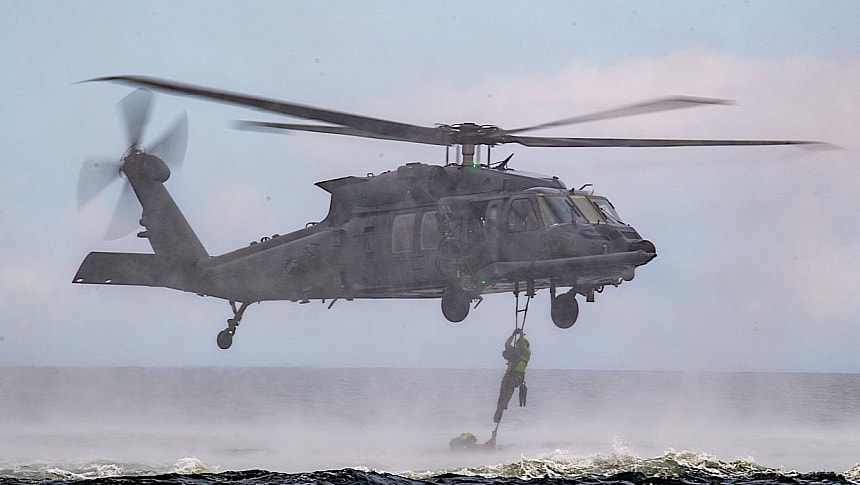The four blades that make up the main rotor of the Sikorsky HH-60W Jolly Green II are not something you want to be near when they spin at full speed. Just have a look at the mess the thing turns its surroundings into as it hovers over the waters of the Atlantic Ocean, throwing water vapor everywhere.
The Jolly Green II is a name you'd better get used to if you are into military vehicles. The thing has been around for just five years, having been introduced as a new variant of the mighty Black Hawk, meant to replace the HH-60G Pave Hawk, but we'll probably hear a lot more about it.
The helicopter, named Jolly Green as a nod to the Vietnam-era helicopters flown into combat by brave American crews, is not meant to be used as an actual tool for battle. Instead, it is a search and rescue machine capable of going in fast and hard, even when battles are going on around it..
Because of the highly dangerous tasks it is meant to perform, the bird, a derivative of the UH-60M Black Hawk, has been designed to be the most modern in the half-century-old breed of helicopters.
It packs integrated mission systems meant to improve situational awareness and new multi-function displays that deliver crucial flight performance information. And it is also as stealthy as helicopters can get, thanks to upturned IR-masking exhausts and improved rotor blades.
The HH-60W is powered by a pair of General Electric turboshaft engines capable of delivering 1,940 shaft horsepower each. That's more than enough to make it capable of lifting 22,500 pounds (10,205 kg) of weight to altitudes as high as 20,000 feet (6,096 meters). The top speed the Jolly Green can reach is 176 mph (283 kph).
This variant of the Black Hawk became operational in 2022, and it performed its first actual rescue mission that same year. Not much is known about it other than it was performed by the 38th and 41st Rescue Squadrons.
The helicopter you see depicted in the main photo of this piece was hovering at very low altitude over the waters in the Gulf of Mexico on June 24, and the U.S. Air Force (USAF) saw it as a fitting image to be included in its weekly release of amazing stills.
The helicopter was on a training mission, and the person you see being pulled from the water, almost entirely engulfed in a sort of inverted rain caused by the helicopter's propellers, was not in any actual danger. Even so, it's an impressive instance of what the rescue chopper is capable of doing.
We expect more and more similar images to come to light as more Jolly Green IIs make it into the aviators' hands. In all, some 113 helicopters of this kind will be deployed by American troops.
The helicopter, named Jolly Green as a nod to the Vietnam-era helicopters flown into combat by brave American crews, is not meant to be used as an actual tool for battle. Instead, it is a search and rescue machine capable of going in fast and hard, even when battles are going on around it..
Because of the highly dangerous tasks it is meant to perform, the bird, a derivative of the UH-60M Black Hawk, has been designed to be the most modern in the half-century-old breed of helicopters.
It packs integrated mission systems meant to improve situational awareness and new multi-function displays that deliver crucial flight performance information. And it is also as stealthy as helicopters can get, thanks to upturned IR-masking exhausts and improved rotor blades.
The HH-60W is powered by a pair of General Electric turboshaft engines capable of delivering 1,940 shaft horsepower each. That's more than enough to make it capable of lifting 22,500 pounds (10,205 kg) of weight to altitudes as high as 20,000 feet (6,096 meters). The top speed the Jolly Green can reach is 176 mph (283 kph).
This variant of the Black Hawk became operational in 2022, and it performed its first actual rescue mission that same year. Not much is known about it other than it was performed by the 38th and 41st Rescue Squadrons.
The helicopter you see depicted in the main photo of this piece was hovering at very low altitude over the waters in the Gulf of Mexico on June 24, and the U.S. Air Force (USAF) saw it as a fitting image to be included in its weekly release of amazing stills.
The helicopter was on a training mission, and the person you see being pulled from the water, almost entirely engulfed in a sort of inverted rain caused by the helicopter's propellers, was not in any actual danger. Even so, it's an impressive instance of what the rescue chopper is capable of doing.
We expect more and more similar images to come to light as more Jolly Green IIs make it into the aviators' hands. In all, some 113 helicopters of this kind will be deployed by American troops.







